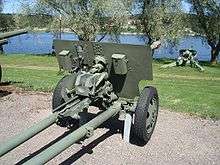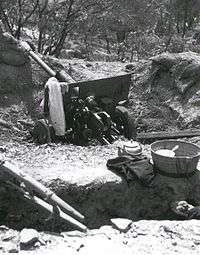76 mm divisional gun M1942 (ZiS-3)
| 76-mm divisional gun M1942 (ZiS-3) | |
|---|---|
_001.jpg) ZiS-3 in Nizhny Novgorod, Russia | |
| Type | Field gun |
| Place of origin | Soviet Union |
| Service history | |
| Wars |
World War II Korean War South African Border War Angolan Civil War Uganda–Tanzania War |
| Production history | |
| Designer | design bureau of No. 92 Artillery Factory headed by V. G. Grabin |
| Produced | 1941–1945 |
| No. built | 103,000+ |
| Specifications | |
| Weight | combat: 1,116 kg(2,460 lbs)travel: 2,150 kg(4,730 lbs)[1] |
| Barrel length | 3.4 m (11 ft 2 in) 42.6 calibers[2] |
| Width | 1.6 m (5 ft 3 in)[2] |
| Height | 1.37 m (4 ft 6 in)[2] |
| Crew | 7 artillerymen |
|
| |
| Shell | Fixed QF 76.2 × 385 mm. R[2] |
| Caliber | 76.2 mm (3 in) |
| Breech | Semi-automatic vertical sliding-wedge[2] |
| Recoil | Hydro-pneumatic[2] |
| Carriage | Split trail |
| Elevation | -5° to +37° |
| Traverse | 54° |
| Rate of fire | up to 25 rounds per minute |
| Maximum firing range | 13.29 km (8.25 mi) |
The 76-mm divisional gun M1942 (ZiS-3) (Russian: 76-мм дивизионная пушка обр. 1942 г. (ЗиС-3)) was a Soviet 76.2 mm divisional field gun used during World War II. ZiS was a factory designation and stood for Zavod imeni Stalina ("factory named after Stalin"), the honorific title of Artillery Factory No. 92, which first constructed this gun.
History
Artillery Factory No. 92 began designing the ZiS-3 at the end of 1940. The ZiS-3 combined the light carriage from the 57 mm ZiS-2 anti-tank gun and the powerful 76.2 mm barrel from the F-22USV, the previous divisional field gun. A muzzle brake was added to reduce recoil, allowing it to be fired without damaging the lighter carriage. Production of the ZiS-3 made greater use of casting, stamping and welding than the F-22USV; compared to the F-22USV, the new weapon was produced with a third of the work, and two-thirds of the cost.
V. G. Grabin, the chief designer of Soviet medium caliber guns, ordered the gun's development on his own initiative. The state was not informed, and the first ZiS-3 was kept hidden. The state had little interest in light and medium field guns. German propaganda about the Neubaufahrzeug multi-turreted prototype tank convinced state authorities that German heavy tanks had exceptionally strong armour, which in turn reduced the value of smaller guns. Marshal Grigory Kulik, commander of Soviet artillery, ordered the production of light 45 mm anti-tank guns and 76.2 mm divisional field guns to be stopped.

The beginning of the Great Patriotic War revealed that the Soviets had overestimated German armour protection. Some were even vulnerable to large caliber DShK machine guns. Pre-war 76 mm divisional guns easily penetrated German vehicles, but nearly all of these guns were lost early in the war; some captured examples were remounted on German Panzerjäger self-propelled guns. Marshal Kulik ordered the F-22USV back into production. Artillery Factory No. 92, in cooperation with Grabin, put the ZiS-3 into mass production from December 1941 instead.
The Red Army initially refused to accept the ZiS-3 - the gun had not undergone the usual acceptance trials - and Artillery Factory No. 92 accumulated a stockpile of serviceable guns. Grabin convinced the army to issue the badly needed guns to units for impromptu testing at the front, where combat experience validated the gun's superiority over all other divisional field guns. Subsequently, the ZiS-3 was presented to Joseph Stalin and a small group of state authorities. Stalin was impressed by the demonstration, saying "This gun is a masterpiece of artillery systems design." The ZiS-3 underwent an official five-day acceptance trial in February 1942, and was then accepted into service as divisional field gun model 1942 (full official name).
Grabin worked to increase production at Artillery Factory No. 92. Conveyor assembly lines admitted the use of low-skilled labour without significant quality loss. Experienced laborers and engineers worked on complicated equipment and served as brigade leaders; they were replaced on the production line by young factory workers who were exempt from conscription, producing a new generation of skilled labourers and engineers. More than 103,000 ZiS-3s were produced by the end of the war, making it the most numerous Soviet field gun during the war.
Mass production of the ZiS-3 ceased after the war. it was replaced by the 85 mm D-44 divisional field gun. The D-44 had better anti-armour capabilities, but inferior mobility due to its increased weight.
The Finns captured 12 units, and designated them 76 K 42.
Self-propelled mounts
The SU-76 was an assault gun mounting the ZiS-3 on the chassis of a T-70 light tank. More than 14,000 were produced between 1942 and 1945.
The Romanian TACAM R-2 tank destroyer was a R-2 tank converted to mount the ZiS-3 in a three-sided fighting compartment. Also, at one point during the development of the Mareșal tank destroyer, the ZiS-3 was fitted on one of the prototypes for trials. Eventually, the Romanians chose their own, superior DT-UDR 75 mm anti-tank gun for the final Mareșal prototypes.
The KSP-76 was a wartime light assault car mounting the ZiS-3; it did not advance beyond the prototype stage.
Ammunition data
| Available ammunition | |||
| Type | Model | Weight, kg | HE weight, g |
| Armour-piercing projectiles (muzzle velocity 700 m/s) | |||
| APHE | BR-350A | 6.3 | 155 |
| AP (solid) | BR-350SP | 6.5 | N/A |
| Composite Armour-piercing projectiles (muzzle velocity up to ? m/s) | |||
| BR-350P | 3.02 | N/A | |
| Developed after World War II | BR-350N | 3.02 | N/A |
| High explosive and fragmentation shells (muzzle velocity 680 m/s) | |||
| HE/Fragmentation steel | OF-350 | 6.2 | 710 |
| HE/Fragmentation steely iron | OF-350A | 6.2 | 640 |
| Fragmentation steely iron | O-350A | 6.21 | 540 |
| HE/Fragmentation | OF-350B | 6.2 | 540 |
| HE/Fragmentation | OF-363 | 6.2 | 540 |
| HE | F-354 | 6.41 | 785 |
| HE | F-354M | 6.1 | 815 |
| HE developed in France | F-354F | 6.41 | 785 |
| Other projectiles (muzzle velocity up to 680 m/s) | |||
| HEAT, developed after World War II | BK-354 | 7 | 740 |
| Shrapnel | Sh-354 | 6.5 | 85 |
| Shrapnel | Sh-354T | 6.66 | 85 |
| Shrapnel | Sh-354G | 6.58 | 85 |
| Shrapnel | Sh-361 | 6.61 | 85 |
| Chemical | OH-350 | 6.25 | |
| Incendiary long-range | Z-350 | 6.24 | 240 |
| Incendiary | Z-354 | 4.65 | 240 |
| Smoke long-range | D-350 | 6.45 | N/A |
| Smoke steely iron | D-350A | 6.45 | N/A |
| Armour penetration table | ||
| AP Projectile BR-350A | ||
| Distance, m | Meet angle 60°, mm | Meet angle 90°, mm |
| 100 | 67 | 82 |
| 500 | 61 | 75 |
| 1000 | 55 | 67 |
| 1500 | 49 | 60 |
| 2000 | 43 | 53 |
| These data were obtained by Soviet methods of armour penetration measurement (penetration probability equals 75%). They are not directly comparable with western data of similar type. | ||
Combat history

Soviet soldiers liked the ZiS-3 for its extreme reliability, durability, and accuracy. The gun was easy to maintain and use by novice crews. The light carriage allowed the ZiS-3 to be towed by trucks, heavy jeeps (like American lend-leased Dodge 3/4), or even hauled by the crew.
The gun was also quite popular with the German Wehrmacht. The gun was introduced into German service as the Kanone 7.62 cm (r) and factories were retooled to produce ammunition for it.
ZiS-3 had good anti-armour capabilities. Its armour-piercing round could knock out any early German light and medium tank. The frontal armour of later tanks, like the Tiger I and later the Panther, were immune to the ZiS-3.
A ZiS-3 battery had four guns; three batteries made a division, or battalion. Independent anti-tank regiments consisted of six batteries with no divisions. A staff battery included a fire control section.
The ZiS-3 saw combat service with North Korean forces during the Korean War (1950–1953).[3] It was also deployed by the People's Armed Forces for the Liberation of Angola (FAPLA) during the Angolan Civil War and the South African Border War[4] and by Tanzania People's Defence Force during Uganda–Tanzania War in 1978-1979.[5]
Post-Cold War
The ZiS-3 was exported to Soviet allies during the Cold War, who in turn exported it to Third World countries. In 2016, the gun remained in active service with the armies of at least six sovereign nations: Cambodia, Nicaragua, Namibia, Sudan, Mozambique, and Tanzania.[6] Mozambique currently operates the largest number of ZiS-3s, with 180 remaining in service.[7] A number of other nations, including Zimbabwe, retain functioning ZiS-3s to fire gun salutes during ceremonial occasions.[8]
Notes
- ↑ Foedrowitz, Michael (1996). Soviet Field Artillery in World War 2. Schiffer Military History. p. 11.
- 1 2 3 4 5 6 Foss, Christopher (1977). Jane's pocket book of towed artillery. New York: Collier. p. 37. ISBN 0020806000. OCLC 911907988.
- ↑ Utz, Curtis A., Assault From the Sea: The Amphibious Landing at Inchon, Naval Historical Center, Department of the Navy, Washington , D.C., 2000, ISBN 0-945274-27-0, p. 30.
- ↑ "Ratel teen tenk en". Port Elizabeth: International Veterans' Association/South African Forces Club. 2011. Archived from the original on 28 July 2012. Retrieved 20 September 2016.
- ↑ Cooper, Tom; Fontanellaz, Adrien (October 2016). "La guerre du Kagera". Batailles et Blindés (in French). No. 75. Caraktère. pp. 72–81. ISSN 1765-0828.
- ↑ "Future Artillery Systems: 2016 Market Report" (PDF). Tidworth: Defence IQ. 2016. Archived from the original (PDF) on 5 August 2016. Retrieved 21 January 2017.
- ↑ Kruger, Anton; Martin, Guy (23 August 2013). "Armed Forces for the Defence of Mozambique". Johannesburg: DefenceWeb. Archived from the original on 19 March 2018. Retrieved 19 March 2018.
- ↑ Chaipa, Edmore (29 November 2013). "Meaning of the Gun Salute". The Herald. Harare, Zimbabwe. Retrieved 28 June 2017.
References
- Shunkov V. N. - The Weapons of the Red Army, Mn. Harvest, 1999 (Шунков В. Н. - Оружие Красной Армии. — Мн.: Харвест, 1999.) ISBN 978-985-433-469-1
External links
| Wikimedia Commons has media related to ZIS-3 76 mm gun. |
